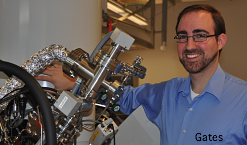
B.C. nanoscale research attracts mega funding
By Design Engineering staff
Materials government funding R&D UniversitySFU material scientists received $884,106 from Western Economic Diversification Canada to enhance Simon Fraser University's capability for materials design and development.

Neil Branda and Byron Gates, Canada research chairs and material scientists, received $884,106 from Western Economic Diversification Canada (WD) to enhance Simon Fraser University’s capability for materials design and development at 4D Labs.
The investment in advanced equipment is the first of its kind in British Columbia and will complement leading-edge research, learning and development underway at 4D Labs, a materials science research centre at SFU. 4D Labs houses materials fabrication and design facilities that enable research-driven technology creation. Funding will accelerate product commercialization and spin-off companies in key sectors such as nanotechnology, energy and life sciences.
Branda and Gates, academic heavyweights in nanotechnology, are using their WD award to build a mask-writing facility, the first of its kind in Canada, for 4D LABS’ nanofabrication laboratory. “This new facility will transform academic and private industry researchers’ ability to cost effectively develop and design new micro- and nanofabricated materials and devices in a timely manner,” says Branda, one of 4D Labs’ founders.
Through lithographic and mask-making processes, scientists pattern materials with nano features that are the foundation of new technology platforms. For example, nano features could form the critical components in electronic and biomedical diagnostic devices.
Currently, scientists in British Columbia have to get masks with micronscale features (from 500 nanometres to more than 100 micrometres in size or about the diameter of a human hair strand) manufactured in Alberta. It has the closest facility for this kind of work.
4D Labs’ new mask-writing facility will enable B.C. scientists to readily create nano- and micronscale features and structures under 20 nanometres (about 10,000 times smaller than the diameter of a human hair strand) in size.
“This installation builds on SFU’s considerable investment in materials science and nanoscience,” said Mario Pinto, vice-president of research at SFU. “This group of researchers is recognized nationally and internationally for their fundamental scholarly efforts, for knowledge transfer to the next generation, and for translating ideas into innovation and commercialization.”
Researchers will also be able to rapidly and directly write features onto materials and structures. This will eliminate the need for extensive lithographic patterning and allow for the creation of 3D nanoscale features.
